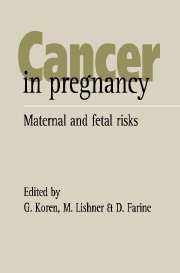Book contents
- Frontmatter
- Contents
- Preface
- List of contributors
- Part I Introduction
- Part II Specific tumors during pregnancy
- Part III Fetal effects of cancer and its treatment
- 16 Prenatal irradiation and cancer
- 17 Review of fetal effects of cancer chemotherapeutic agents
- 18 Fetal outcome following in utero exposure to cancer chemotherapy: the Toronto Study
- 19 Intrauterine causes of tumors in later life
- 20 Fetal tumors
- Index
20 - Fetal tumors
from Part III - Fetal effects of cancer and its treatment
Published online by Cambridge University Press: 06 July 2010
- Frontmatter
- Contents
- Preface
- List of contributors
- Part I Introduction
- Part II Specific tumors during pregnancy
- Part III Fetal effects of cancer and its treatment
- 16 Prenatal irradiation and cancer
- 17 Review of fetal effects of cancer chemotherapeutic agents
- 18 Fetal outcome following in utero exposure to cancer chemotherapy: the Toronto Study
- 19 Intrauterine causes of tumors in later life
- 20 Fetal tumors
- Index
Summary
The inclusion of a chapter on fetal tumors in this book largely reflects the increasing detection over the past decade of “abnormal growths” during prenatal ultrasound. Tumors may be defined as local swellings from morbid or abnormal growth. The vast majority of fetal tumors are benign and can range from small lesions which may resolve, as in the case of some ovarian cysts, to aggressive, rapidly growing masses which, depending on their size and location, can be lethal or cause serious morbidity as occasionally seen with large sacrococcygeal tumors. Although there is an expanding body of literature on the subject, fetal tumors are rare and individual experience within any one unit is small. Before embarking on attempted treatment of a disease, it is imperative that the natural history of the disease be known. Unfortunately, termination of pregnancy and a variety of invasive techniques have often been performed without clear knowledge of the risk-benefit ratio. Acknowledging that these tumors are relatively rare, this chapter will attempt to discuss the incidence, pathology, natural history, ultrasonic appearance, differential diagnosis and management of tumors diagnosed in utero.
Teratoma
The most frequently diagnosed fetal tumor is a teratoma1 and it is perhaps an exception to the above criticisms in that, because of its relative frequency when compared with other tumors, its natural history is reasonably well understood. In males exposed to DES, no carcinogenesis has been demonstrated.
- Type
- Chapter
- Information
- Cancer in PregnancyMaternal and Fetal Risks, pp. 205 - 213Publisher: Cambridge University PressPrint publication year: 1996

